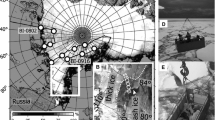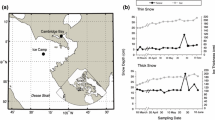Summary
Pack ice surrounding Antarctica supports rich and varied populations of microbial organisms. As part of the Antarctic Marine Ecosystem Research in the Ice Edge Zone (AMERIEZ) studies, we have examined this community during the late spring, autumn, and winter. Although organisms are found throughout the ice, the richest concentrations often occur in the surface layer. The ice flora consists of diatoms and flagellates. Chrysophyte cysts (archaeomonads) of unknown affinity and dinoflagellate cysts are abundant and may serve as overwintering stages in ice. The ice fauna includes a variety of heterotrophic flagellates, ciliates, and micrometazoa. The abundance of heterotrophs indicates an active food web within the ice community. Ice may serve as a temporary habitat or refuge for many of the microbial forms and some of these appear to provide an inoculum for planktonic populations when ice melts. Larger consumers, such as copepods and the Antarctic krill, Euphausia superba are often found on the underside of ice floes and within weathered floes. The importance of the ice biota as a food resource for these pelagic consumers is unknown.
Similar content being viewed by others
References
Ackley SF (1985) Pressure ridge associated microbial communities in Antarctic sea ice. EOS 66:1278
Ackley SF, Buck KR, Taguchi S (1979) Standing crop of algae in the sea ice of the Weddell Sea region. Deep-Sea Res 26A:269–281
Andriashev AP (1968) The problem of life community associated with the Antarctic fast ice. In: Currie RI (ed) Symp Antarct Oceanogr. Scott Polar Res Inst, Cambridge, pp 147–155
Beers JR, Stewart GL (1970) Numerical abundance and estimated biomass of microzooplankton. In: Strickland JDH (ed) The ecology of the plankton off La Jolla, California in the period April through September, 1967. Bull Scripps Inst Oceanogr 17:67–87
Børsheim KY, Bratbak G (1987) Cell volume to cell carbon conversion factors for a bactivorous Monas sp. enriched from seawater. Mar Ecol Prog Ser 36:171–175
Bolt PA, Buck KR, Garrison DL (1988) A phagotrophic dinoflagellate associated with sea ice communities in the Weddell Sea, Antarctica. JPhycol (Abstr) 24(s):12
Booth BC (1988) Size classes and major taxonomic groups of phytoplankton at two locations in the subarctic Pacific Ocean in May and August 1984. Mar Biol 97:275–286
Buck KR, Garrison DL (1983) Protists from the ice-edge region of the Weddell Sea. Deep-Sea Res 30:1261–1277
Buck KR, Garrison DL (1988) Distribution and abundance of choanoflagellates (Acanthoecidae) across the ice edge zone in the Weddell Sea. Mar Biol 98:236–269
Buck KR, Bolt PA, Garrison DL (in press) Phagotrophy and fecal pellet production by an athecate dinoflagellate in Antarctic sea ice. Mar Ecol Prog Ser
Buck KR, Bolt PA, Garrison DL (in press) Dinoflagellate cysts associated with Antarctic pack-ice communities. 4th Internat Conf Living and Fossil Dinoflagellates (Abstr). Am Assoc Stratigr Palyn
Burkholder PR, Mandelli EF (1965) Productivity of microalgae in Antarctic sea ice. Science 148:872–874
Burkill PH (1982) Ciliates and other microplankton components of a nearshore food-web: standing stocks and production processes. Ann Inst Oceanogr, Paris 58(s):335–350
Bunt JS, Lee CC (1970) Seasonal primary production in Antarctic sea ice at McMurdo Sound in 1967. J Mar Res 28:304–320
Bunt JS, Lee CC (1972) Data on the composition and dark survival of four sea ice microalgae. Limnol Oceanogr 17:458–461
Buynitskiy VKh (1968) The influence of microalgae on the structure and strength of Antarctic sea ice. Oceanology 8:771–776
Carey AG Jr (1985) Marine ice fauna: Arctic. In: Horner R (ed) Sea ice biota. CRC Press, Boca Raton, Florida, pp 173–190
Caron DA (1983) Technique for enumeration of heterotrophic and phototrophic nanoplankton, using epifluorescence microscopy, and comparison with other procedures. Appl Environ Microbiol 49:491–498
Clarke DB, Ackley SF (1984) Sea ice structure and biological activity in the Antarctic marginal ice zone. J Geophys Res 89:2087–2095
Corliss JO, Snyder RA (1986) A preliminary description of seven new ciliates from Antarctica including Cohnilembus grassei n. sp. Protistologica 22:39–46
Dahms H-U, Dieckmann GS (1987) Drescheriella glacialis gen. nov., sp. nov. (Copepoda, Harpacticoida) from Antarctic sea ice. Polar Biol 7:329–337
Daly KL, Macaulay MC (1988) Abundance and distribution of krill in the ice edge zone of the Weddell Sea, austral spring 1983. Deep-Sea Res 35:21–41
Dieckmann GS, Lange MA, Ackley SF (1986) Sea ice biota and ice formation processes in the Weddell Sea during winter. EOS 67:1005
Eppley RW, Reid FMH, Strickland JDR (1970) Estimates of phytoplankton crop size, growth rate, and primary production. In: Strickland JDR (ed) The ecology of the phytoplankton off La Jolla, California in the period April through September, 1967. Bull Scripps Inst Oceanogr 17:33–42
Fenchel T (1982) Ecology of heterotrophic microflagellates. II. Bioenergetics and growth. Mar Ecol Prog Ser 8:225–231
Fenchel T, Lee CC (1972) Studies on ciliates associated with sea ice from Antarctica. I. The nature of the fauna. Arch Protistenkd 114:231–236
Foster TD (1984) The marine environment. In: Laws RM (ed) Antarctic ecology, volume 2. Academic Press, London, pp. 345–371
Fukushima H, Meguro H (1966) The plankton ice as a basic factor of the primary productivity of the Antarctic Ocean. Antarct Rec 27:99–101
Garrison DL, Buck KR (1985) Sea-ice algal communities in the Weddell Sea: species composition in ice and planktonic assemblages. In: Gray JS, Christiansen ME (eds) Marine Biology of polar regions and stress on marine organisms. John Wiley, New York, pp 103–122
Garrison DL, Buck KR (1986) Organism losses during ice melting: a serious bias in sea ice community studies. Polar Biol 6:237–239
Garrison DL, Buck KR (1989) Protozooplankton in the Weddell Sea, Antarctica: abundance and distribution in the ice-edge zone. Polar Biol 9:341–351
Garrison DL, Buck KR, Silver MW (1982) Ice algal communities in the Weddell Sea. Antarctic J US 17:157–159
Garrison DL, Ackley SF, Buck KR (1983) A physical mechanism for establishing algal populations in frazil ice. Nature (London) 306:363–365
Garrison DL, Sullivan CW, Ackley SF (1986) Sea ice microbial communities in Antarctica. BioScience 36:243–250
Garrison DL, Buck KR, Fryxell GA (1987) Algal assemblages in Antarctic pack ice and in ice-edge plankton. J. Phycol 23:564–572
Gold K (1976) Methods for preserving Tintinnida. In: Steedman HF (ed) Zooplankton fixation and preservation. UNESCO, Paris, pp 236–239
Grossi SM, Sullivan CW (1985) Sea ice microbial communities. V. The vertical zonation of diatoms in Antarctic fast ice community. J Phycol 21:401–409
Gruzov YeN, Propp MV, Pushkin AF (1967) Biological associations of coastal areas of the Davis Sea (based on the observations of divers). Sov Antarct Exped Inf Bull 6:523–533
Hamner WH, Hamner PP, Strand SW, Gilmer RW (1983) Behavior of Antarctic Krill, Euphausia superba: chemoreception, feeding, schooling, and molting. Science 220:433–435
Hamner WH, Hamner PP, Obst BS, Carlton JH (1989) Field observations on the ontogeny of schooling of Euphausia superba furcilliae and its relationship to ice in Antarctic Waters. Limnol Oceanogr 34:451–455
Heinbokel JF (1978) Studies on the functional role of tintinnids in the Southern California bight. I. Grazing and growth rates in laboratory cultures. Mar Biol 47:177–189
Holm-Hansen O, Huntley M (1984) Feeding requirements of krill in relation to food sources. J Crust Biol 4:156–173
Hooker JD (1847) The botany of the Antarctic voyage of HM Discovery Ships Erebus and Terror in the Years 1839–1843. I. Flora Antarctica. J Cramer, Weinheim
Horner R (1985a) History of ice algal investigations. In: Horner R (ed) Sea ice biota. CRC Press, Boca Raton, Florida, pp 1–19
Horner R (1985b) Ecology of sea ice microalgae In: Horner R (ed) Sea ice biota, CRC Press, Boca Raton, Florida, pp 83–103
Horner R (1985c) Taxonomy of sea ice microalgae. In: Horner R (ed) Sea ice biota, CRC Press, Boca Raton, Florida, pp 147–157
Horner RA, Syvertsen FE, Thomas DP, Lange C (1988) Proposed terminology and reporting units for sea ice assemblages. Polar Biol 8:249–253
Hoshiai T (1981) Proliferation of ice algae in the Syowa station area, Antarctica. Mem Natl Inst Polar Res 34:1–12
Hoshiai T, Kato M (1961) Ecological notes in the diatom community in the sea ice in Antarctica. Bull Mar Biol Stn Asamushi, Tohoku Univ 10:221–230
lizuka H, Tanabe I, Meguro H (1966) Microorganisms in plankton-ice of the Antarctic Ocean. J Gen Appl Microbiol 12:101–102
Kottmeier ST, Sullivan CW (1987) Late winter primary production and bacterial production in sea ice and seawater west of the Antarctic Peninsula. Mar Ecol Prog Ser 36:287–298
Kovola TE, Larrance JD (1966) Computation of phytoplankton cell numbers, cell volume, cell surface and plasma volume per liter from microscopical counts. Spec Sci Rep No 38, Univ of Washington, Dept of Oceanography, Ref M66-41
Lipps JH, Krebs WN (1974) Planktonic foraminifera associated with Antarctic sea ice. J Foraminiferal Res 4:80–85
Marchant HJ (1985) Choanoflagellates in the Antarctic food chain. In: Siegfreid WR, Condy PR, Laws RM (eds) Antarctic nutrient cycles and food webs. Springer, Berlin, pp 271–276
Marschall H-P (1988) The over wintering strategy of Antarctic krill under the Weddell Sea. Polar Biol 9:129–135
McConville MJ, Wetherbee R (1983) The bottom-ice microalgal community from annual ice in the inshore waters of east Antarctica. J Phycol 19:431–439
Meguro H (1962) Plankton ice in the Antarctic Ocean. Antarct Rec 14:1192–1199
Miller MA, Krempin DW, Manahan DT, Sullivan CW (1984) Growth rates, distribution, and abundance of bacteria in the ice-edge zone of the Weddell and Scotia Seas, Antarctica. Antarct J US 19:103–105
Mitchell JG, Silver MW (1982) Modern archaeomonads indicate sea-ice environments. Nature (London) 296:437–439
Mullin MM, Sloan PR, Eppley RW (1966) Relationship between carbon content, cell volume, and area in phytoplankton. Limnol Oceanogr 11:307–311
O'Brien DP (1987) Direct observations of the behavior of Euphausia superba and Euphausia crystallorphias (Crustacea: Euphasusiacea) under pack ice during the Antarctic spring. J Crustacean Biol 7:437–448
Palmisano AC, Sullivan CW (1982) Physiology of sea ice diatoms. I. Response of three polar diatoms to a simulated summer-winter transition. J Phycol 18:489–498
Parsons TR, Maita Y, Lalli CM (1984a) Fluorometric determination of chlorophylls. In: A manual of chemical and biological methods for seawater analysis. Pergamon, New York, pp 107–110
Parsons TR, Takahashi M, Hargrave B (1984b) Biological oceanographie processes. Pergamon, New York, pp 37–60
Rakusa-Suszczewski S (1972) The biology of Paramoera walkeri Stebbing (Amphipoda) and the Antarctic sub-fast ice community. Pol Arch Hydrobiol 19:11–36
Reid FMH (1983) Biomass estimation of components of marine nano-plankton and picoplankton by the Utermohl method. J Plankton Res 5:235–251
Richardson MG, Whitaker TM (1979) An Antarctic fast-ice food chain: observations on the interaction of the amphipod Pontogeneia antarctica Chevreux with ice-associated micro-algae. Br Antarct Surv Bull 47:107–15
Spindler M, Dieckmann GS (1986) Distribution and abundance of the planktic foraminifer Neogloboquadrina pachyderma in sea ice of the Weddell Sea (Antarctica). Polar Biol 5:185–191
Strathman RR (1967) Estimating the organic carbon content of phytoplankton from cell volume or plasma volume. Limnol Oceanogr 12:411–418
Sullivan CW, Palmisano AC (1984) Sea ice microbial communities: distribution, abundance, and diversity of ice bacteria in McMurdo Sound, Antarctica in 1980. Appl Environ Microbiol 47:788–795
Sullivan CW, Palmisano AC, Kottmeier ST, Moe R (1982) Development of the sea ice microbial communities (SIMCO) in McMurdo Sound, Antarctica. Antarctic J US 17:155–157
Turley CM, Newell RC, Robins DB (1986) Survival strategies of two small ciliates and their role in regulating bacterial community structure under experimental conditions. Mar Ecol Prog Ser 33:59–70
Takahashi E (1981) Loricate and scale-bearing protists from Lutzow-Holm Bay, Antarctica. I. Species of Acanthoecidae and the Centrohelida found at a site selected on the fast ice. Antarct Rec 73:1–22
Whitaker TM (1977) Sea ice habitats of Signy Island (South Orkneys) and their primary productivity, adaptations within Antarctic ecosystems. In: Llano GA (ed) Adaptations within Antarctic ecosystems. Gulf Publishing, Houston, Texas, pp 75–82
Author information
Authors and Affiliations
Rights and permissions
About this article
Cite this article
Garrison, D.L., Buck, K.R. The biota of Antarctic pack ice in the Weddell sea and Antarctic Peninsula regions. Polar Biol 10, 211–219 (1989). https://doi.org/10.1007/BF00238497
Received:
Accepted:
Issue Date:
DOI: https://doi.org/10.1007/BF00238497




